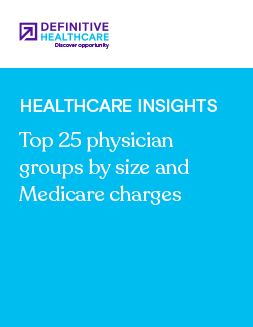Healthcare Insights
How many urgent care centers are in each U.S. state?
Urgent care centers (also known as urgent care clinics) have become a key part of the U.S. healthcare landscape, offering an alternative to emergency rooms (ERs) for non-life-threatening medical conditions.
Convenience, high costs of ER visits, and increased investment by health systems are a few factors fueling urgent care’s growth—and we will likely continue to see it grow as patient care preferences continue to shift away from the hospital.
Using data from ClinicView, we compiled a list of urgent care centers in the U.S. in 2025. Keep reading to find out where these clinics are located and how urgent care centers differ from other care settings.
Number of urgent care centers in each state
Fig. 1 Data is from the Definitive Healthcare ClinicView product. The number of facilities represents only those urgent care clinics listed as “active” in the Definitive Healthcare database as of June 2025.
How many urgent care clinics are in the U.S.?
There were 11,877 active urgent care clinics in the U.S. as of June 2025. These centers offer convenient healthcare services for people who require immediate medical attention but do not have an emergency medical condition.
More than half of all clinics were concentrated across ten densely populated states, including California (10%), Texas (8%), and Florida (7%). Metropolitan areas with the highest numbers of urgent care clinics are detailed below.
| Rank | CBSA | # of urgent care centers | Explore dataset |
|---|---|---|---|
| 1 | New York-Newark-Jersey City NY-NJ | 787 | Explore |
| 2 | Los Angeles-Long Beach-Anaheim CA | 466 | Explore |
| 3 | Dallas-Fort Worth-Arlington TX | 304 | Explore |
| 4 | Atlanta-Sandy Springs-Roswell GA | 299 | Explore |
| 5 | Chicago-Naperville-Elgin IL-IN | 296 | Explore |
| 6 | Houston-Pasadena-The Woodlands TX | 263 | Explore |
| 7 | Detroit-Warren-Dearborn MI | 257 | Explore |
| 8 | Washington-Arlington-Alexandria DC-VA-MD-WV | 245 | Explore |
| 9 | Miami-Fort Lauderdale-West Palm Beach FL | 245 | Explore |
| 10 | Philadelphia-Camden-Wilmington PA-NJ-DE-MD | 180 | Explore |
Fig. 2 Data is from the Definitive Healthcare ClinicView product. The number of facilities represents urgent care clinics listed as “active” in the Definitive Healthcare database as of June 2025.
For more information on the latest urgent care trends, check out our Healthcare Insights on the top urgent care clinics ranked by patient population.
What services do urgent care clinics provide?
An urgent care center is a medical facility that provides immediate medical treatment for non-life-threatening medical conditions. These centers are open for extended hours, including evenings and weekends, and do not require appointments, allowing patients to receive medical care on a walk-in basis.
Urgent care clinics are equipped to treat a wide range of conditions, including minor injuries, illnesses, and infections that require prompt medical attention but aren’t serious enough to warrant a visit to the emergency room.
How do urgent care clinics differ from retail clinics?
Retail clinics and urgent care clinics are grouped together as convenient care clinics because both offer extended hours and accept walk-in appointments. The main difference between retail clinics and urgent care centers is the level of care that they provide. Retail clinics treat a limited range of minor, acute conditions, such as allergies, colds, and infections.
Urgent care clinics, which have on-site diagnostic equipment and procedure rooms, can offer a broader range of care for non-life-threatening conditions that need immediate attention, such as splinting and casting for broken bones or minor laceration and wound repair.
To qualify as an urgent care clinic in Definitive Healthcare’s ClinicView product, a facility must meet the American Academy of Urgent Care Medicine and the Urgent Care Association of America's primary requirements. These include:
- Accept walk-in patients
- Offer extended hours
- Treat a broad spectrum of illnesses and injuries
- Procedure room for performing minor medical procedures (e.g., stitches, casts, low-risk surgery under a local anesthetic only)
- Multiple exam rooms
- On-site diagnostic equipment (e.g., phlebotomy and x-ray)
- Communication lines with local hospitals for streamlined transfers to ERs
What’s the difference between urgent care and an emergency room in the U.S.?
Urgent care clinics and emergency rooms serve very different purposes in the healthcare system. As mentioned above, urgent care centers provide medical care for conditions that require prompt attention but are not life-threatening. Emergency rooms, on the other hand, are equipped to handle life-threatening medical conditions like heart attacks, strokes, severe bleeding, loss of consciousness, and more.
Emergency rooms also operate 24 hours a day, seven days a week. Urgent care centers are not designed for patients to stay overnight, though many facilities are open beyond regular office hours, including evenings and weekends.
Finally, due to the more critical level of care required and resources available, services provided in an emergency room are typically more expensive than those in urgent care centers.
Learn more
Healthcare Insights are developed with healthcare data and analytics from the Definitive Healthcare platform. Want even more insights? Start a free trial now and get access to the latest healthcare commercial intelligence on hospitals, physicians, and other healthcare providers.


